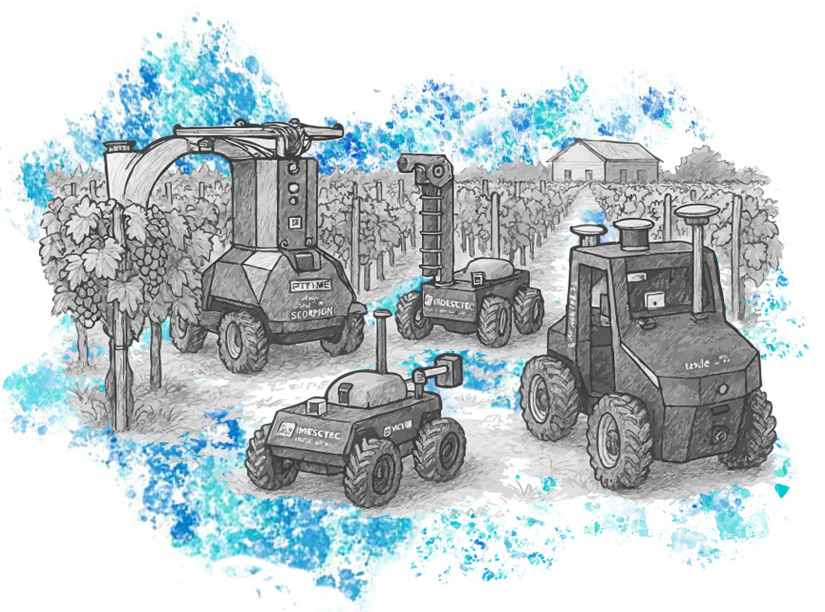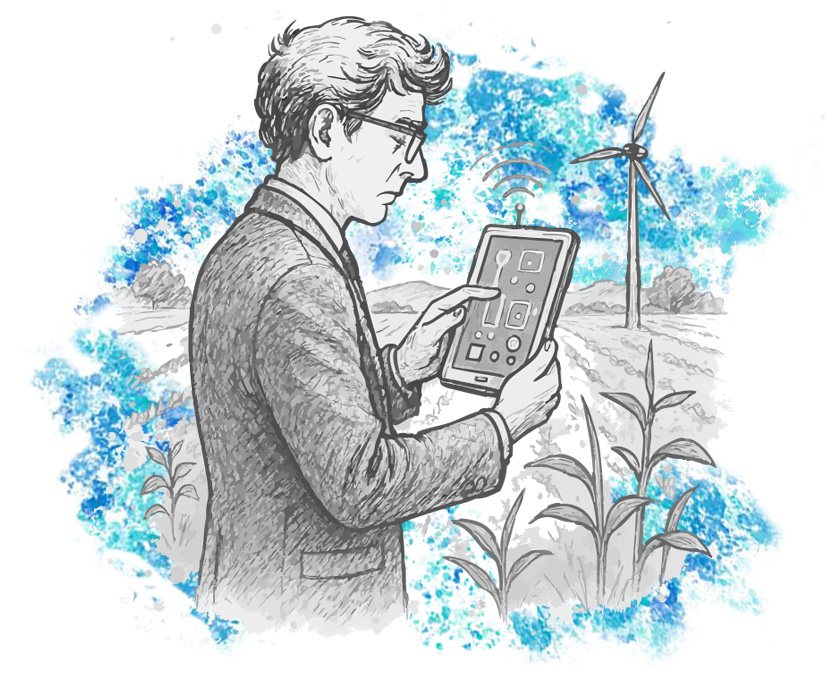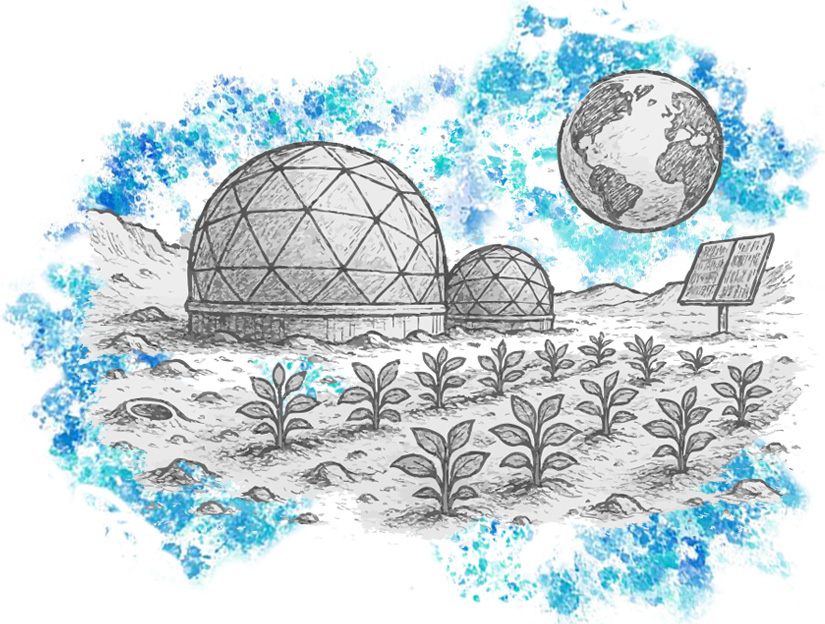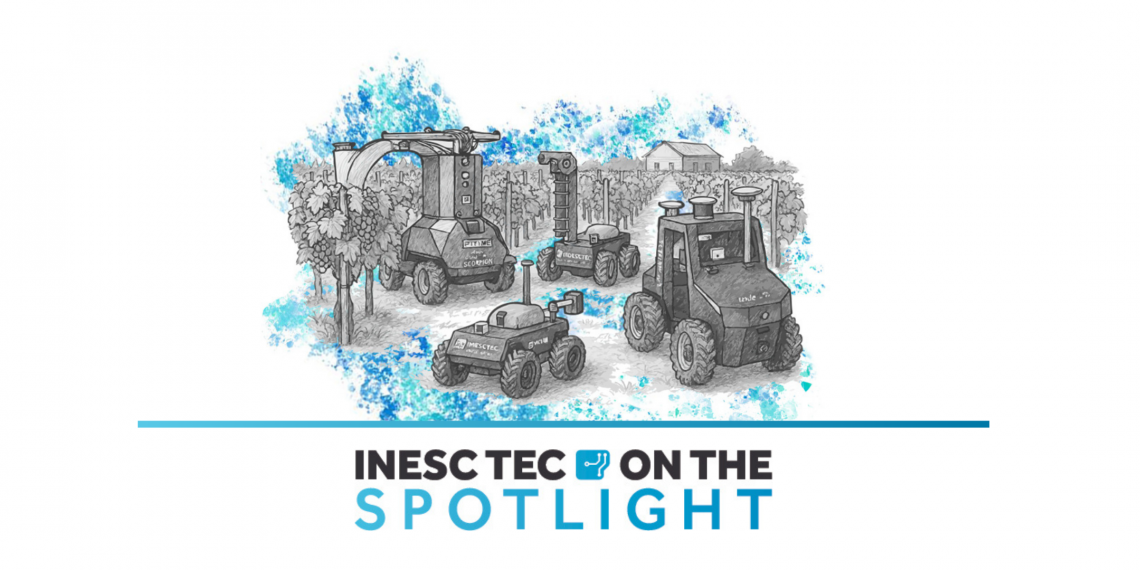When we think of agriculture, the image that comes to mind is of farmers with hoes in hand, tractors ploughing the earth, or harvesters under the sun. But the future looks quite different. Robots, sensors, and geospatial knowledge infrastructures are not merely promises – they are inevitable. From the lab to the field, INESC TEC aims to revolutionise the agricultural (including winegrowing) and forestry sectors, making them more precise, intelligent, and sustainable. So, what does the future look like?
According to the United Nations’ Food and Agriculture Organization (FAO), between 2000 and 2022, global agricultural production increased by 56%. In Portugal, the trend is similar, with average annual growth of around 2.6% between 2012 and 2022 – driven by the introduction of new technologies – including mechanisation, automation, and robotisation (featuring autonomous robots), as well as sensors and data analysis platforms. The benefits? Less demanding work, more efficient resource use, solutions to labour shortages, greater environmental sustainability (by reducing excessive use of water, fertilisers and pesticides), and greater resilience to climate change.[1]
At INESC TEC, a multidisciplinary team of engineers, programmers, agronomists, and information systems experts is leading a revolution in the agricultural and forestry sectors -with real impact on sustainability, productivity, and even public health.
Robots adapted to agriculture
With this vision in mind, INESC TEC researcher Filipe Santos began applying robotics to agriculture. A decade later, he now leads a laboratory – the TRIBE Lab (Laboratory of Robotics and IoT for Smart Precision Agriculture and Forestry) at INESC TEC -, developing solutions that could transform the sector and even address global challenges. “In 2014, we analysed vineyards, particularly in the Douro region, and realised there were serious issues with access to labour and machinery. It seemed natural to explore whether the technologies we already had could be adapted to that environment,” he recalled.

Like a modern-day Frankenstein, Filipe set out to develop a new system from scratch, in collaboration with partners like ADVID (Associação para o Desenvolvimento da Viticultura Duriense), Sogrape, and local growers. While some initially viewed the idea with scepticism, it quickly proved effective in addressing long-standing challenges: lack of efficient equipment, difficulty navigating steep terrain, oversized machinery with poor return on investment, and a lack of tailored solutions for smaller properties.
“We realised we could only make a real difference if we had the capability to develop everything – from the idea to the working prototype. We don’t want massive machines compacting the soil and repeating the same task, whether in the field or the forest,” he explained.
They began with a robot for vineyard monitoring, which evolved into WETA – the first robot fully designed from the ground up for precision spraying. This led to a new concept: modular robots that can adapt to different tasks and are easy to transport; they spray, fertilise, monitor, cut vegetation, and meet the needs of a still highly fragmented sector. Modular-E (for agriculture) and Modular-X (for forestry) are the key components of this LEGO-like concept.
Sensors and traps: the quiet revolution
Remember Q from James Bond? At INESC TEC, we have our own behind-the-scenes mastermind. Instead of explosive pens, Lino Oliveira and his team work with geospatial knowledge infrastructures, sensors, and traps.
Their first step came with the FDControlo project. The mission? To monitor vineyard pests, particularly Scaphoideus titanus, the insect that causes flavescence dorée. Traditionally, this was done using sticky traps (chromotropic panels) placed in the vineyard and checked manually. “The problem was that everything relied on visual inspection – it was time-consuming, labour-intensive, and often imprecise. So why not create a robotic trap that automatically takes photos and sends them for analysis?” said Lino Oliveira.
This intelligent trap, equipped with a solar panel, camera, GSM connection, and environmental sensors, sends images to a central server. With the help of trained algorithms, it can automatically detect the disease vector.
Building on FDControlo’s success, the InOlive project applied the same approach to olive groves, targeting the olive fruit fly and olive moth – proving the scalability of the technology. “We knew what to do: how to train the algorithms, build the traps, collect the data. We created an integrated solution with smart traps, trained algorithms, and an information system with automatic alerts.”
In greenhouses like GreenTribe, located at INESC TEC’s headquarters, low-cost and open-source technologies are being tested for urban food production. “Greenhouses let us test faster, model plants, and experiment in a controlled setting. They’re essential for preparing the transition to more efficient agriculture,” added Filipe Santos.

Predict, anticipate, act
At INESC TEC, there’s no crystal ball – but it’s almost as if we can see the future. In the Douro region, the Infravini project used a network of weather stations to gather real-time data, cross-referencing it with 20 years of historical records to create hydrological, thermal and phenological indicators.[2] The project democratised access to valuable information, previously only available to large producers. “The goal is to know, for example, when a vine reaches a particular growth stage, to forecast heatwaves or identify higher-risk zones. It’s a decision-support tool based on solid data and forecasting,” explained Lino Oliveira.
“This is the Holy Grail of precision viticulture: knowing which vine produces the most, so we can treat each one differently, apply nutrients only where needed, and remove plants that are simply draining resources,” added Filipe Santos.
Agriculture and viticulture don’t live by land alone; the WaterkNow project – still in the early stages -, aims to build an advanced geospatial knowledge infrastructure capable of predicting water shortages 7 to 10 days in advance and supporting strategic water management with medium- and long-term models. “With these forecasts, we can better plan irrigation, avoid waste, and ensure resilience,” said Lino Oliveira.
Another project in development involves installing over a thousand intelligent traps across the country and using a digital twin to run simulations and tests. “Imagine a real-time map showing exactly what’s happening on the ground. We can then introduce data and see how the system reacts – understanding, in the digital space, what will happen in the real world, without risking crops, and enabling more informed decisions,” explained Lino Oliveira.
From the lab to the market
“Nowadays, no one is surprised to see robots in vineyards or sensors collecting data from the air.” According to André Sá, business developer for TEC4AGRO-FOOD – INESC TEC’s initiative for the agro-food and forestry sectors – the introduction of technology into agriculture isn’t just a growing trend; it’s an irreversible process.
“INESC TEC’s structure – comprising several highly specialised R&D domains – enables us to build solutions to real problems. We have dozens of advanced prototypes. The next step is transferring the technology to companies that can turn them into market-ready products,” he said.
André Sá emphasised that INESC TEC is already a national benchmark and gaining European recognition in digital and robotic technologies for agro-food and forestry. But bringing tech to market isn’t easy: “it’s easier to deliver software; hardware requires companies capable of building, testing, and scaling. Then there’s the ecosystem: the end user, the regulator, the market.” However, the signs are promising. “Years ago, at events, people would say, ‘Aren’t you from IT? What are you doing in agriculture?’ Today, we witness real changes – producers shifting behaviour, the DGAV (General Directorate for Food and Veterinary Affairs) updating methodologies based on our projects, and major wine producers adapting to the solutions we helped develop,” he said.

INESC TEC is not a manufacturer; instead, it partners with tech companies to transfer lab-developed technologies. “We have over 30 technologies with market potential. Our dream is to see robots ‘powered by INESC TEC’ working in vineyards, greenhouses, and forests across the country. But more than that, we want those technologies to reach the field and truly help people,” added Filipe Santos.
“The innovation triangle – end users, academia, and tech companies – is well-established,” said André Sá. Over the next two to three years, the first market results should begin to emerge: productivity gains, efficiency, and loss reduction. And the future? “Once we’ve transferred these technologies, we’ll keep inventing; research can’t stop. We have a vision for projects around food production in water, on the Moon… things that today seem outlandish may be what we transfer a decade from now.”
As Filipe Santos reminded us, there’s something poetic in the whole process. “We’re trying to give back to the land what industrialisation took away: diversity, balance, intelligence. For decades, agriculture was forced to adapt to machines – resulting in monocultures and lost biodiversity. We want to do the opposite: build machines that adapt to agriculture and help preserve biodiversity.”
The researchers mentioned are associated with INESC TEC and FCUP.



 News, current topics, curiosities and so much more about INESC TEC and its community!
News, current topics, curiosities and so much more about INESC TEC and its community!